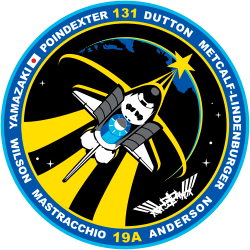Richard A. Mastracchio
| Richard Alan "Rick" Mastracchio | |
 | |
| NASA-astronaut | |
|---|---|
| Född | 11 februari 1960 Waterbury, Connecticut |
| Tid i rymden | 227 dagar, 13 timmar, 38 minuter |
| Urvalsgrupp | Astronautgrupp 16 |
| Antal rymdpromenader | 9 st |
| Rymdpromenadtid | 53 timmar, 4 minuter |
| Uppdrag | STS-106, STS-118, STS-131, Sojuz TMA-11M, Expedition 38/39 |
| Uppdragsemblem | |
Richard Alan Mastracchio, född 11 februari 1960 i Waterbury, Connecticut, är en amerikansk astronaut uttagen i astronautgrupp 16 den 5 december 1996.
Rymdfärder
Referenser
- ^ ”Expedition 38” (på engelska). NASA. https://www.nasa.gov/mission/expedition-38/. Läst 24 februari 2024.
- ^ ”Expedition 39” (på engelska). NASA. https://www.nasa.gov/mission/expedition-39/. Läst 24 februari 2024.
Media som används på denna webbplats
STS118-S-001 (May 2007) --- The STS-118 patch represents Space Shuttle Endeavour on its mission to help complete the assembly of the International Space Station (ISS), and symbolizes the pursuit of knowledge through space exploration. The flight will accomplish its ISS 13A.1 assembly tasks through a series of spacewalks, robotic operations, logistics transfers, and the exchange of one of the three long-duration expedition crew members. On the patch, the top of the gold astronaut symbol overlays the starboard S-5 truss segment, highlighting its installation during the mission. The flame of knowledge represents the importance of education, and honors teachers and students everywhere. The seven white stars and the red maple leaf signify the American and Canadian crew members, respectively, flying aboard Endeavour.
Astronaut Richard A. (Rick) Mastracchio, mission specialist.
ISS Expedition 38 Patch
As the International Space Station (ISS) has become a stepping stone to future space exploration, the Expedition 38 mission patch design paints a visual roadmap of exploration beyond low Earth orbit, most prominently represented by the design's flowing Expedition 38 mission numbers that wrap around Earth, the moon and Mars. Just as the sun is a guiding light in the galaxy, the ISS illuminates the bottom of the design as it is a shining beacon of the advancement of science, knowledge, and technology carried out aboard the Space Station. To visually capture the idea of the ISS being a foundation for infinite discovery, the space station's iconic solar arrays span upwards, providing the number 38 and its exploration roadmap a symbolic pedestal to rest on. Finally, the overall use of red, white, and blue in the design acknowledges the flags of the countries of origin for Expedition 38's crew -- the United States, Russia, and Japan.
The STS-131/19A crew patch highlights the Space Shuttle in the Rendezvous Pitch Maneuver (RPM). This maneuver is heavily photographed by the International Space Station (ISS) astronauts, and the photos are analyzed back on earth to clear the Space Shuttle's thermal protection system for re-entry. The RPM illustrates the teamwork and safety process behind each Space Shuttle launch. In the Space Shuttle's cargo bay is the Multi-Purpose Logistics Module (MPLM), Leonardo, which is carrying several science racks, the last of the four crew quarters, and supplies for the ISS. Out of view and directly behind the MPLM, is the Ammonia Tank Assembly (ATA) that will be used to replace the current ATA. This will take place during three Extra Vehicular Activities (EVAs). The 51.6° Space Shuttle orbit is illustrated by the three gold bars of the astronaut symbol, and its elliptical wreath contains the orbit of the ISS. The star atop the astronaut symbol is the dawning sun, which is spreading its early light across the Earth. The background star field contains seven stars, one for each crewmember; they are proud to represent the United States and Japan during this mission.
This is the crew patch for the STS-106 mission, which is the first Shuttle flight to the International Space Station since the arrival of its newest component, the Russian-supplied Service Module Zvezda (Russian for star). Zvezda is depicted on the crew patch mated with the already orbiting Node 1 Unity module and Russian-built Functional Cargo Block, called Zarya (sunrise), with a Progress supply vehicle docked to the rear of the Station. The International Space Station is shown in orbit with Earth above as it appears from the perspective of space. The Astronaut Office symbol, a star with three rays of light, provides a connection between the Space Shuttle Atlantis and the Space Station, much the same as the Space Shuttle Program is linked to the International Space Station during its construction and future research operations. Stylized versions of flags from Russia and the United States meet at the Space Station. They symbolize both the cooperation and joint efforts of the two countries during the development and deployment of the permanent outpost in space as well as the close relationship of the American and Russian crew members.





